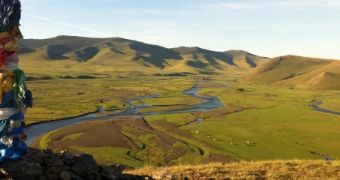American investigators at the West Virginia University determined in a new study that ancient climate patterns may have unknowingly aided Mongol emperor and conqueror Genghis Khan in his campaign to subdue most of Eurasia. The team arrived at this conclusion through a careful analysis of tree rings from areas that were conquered by the Mongols through 1227.
The investigation paid close attention to how the emperor and his troops expanded the Mongol Empire through northeastern Asia. Many historians have suggested that climate played an important role in human history, even if unbeknown to people living at the time. These conclusions are a clear piece of evidence supporting this belief, alongside recent discoveries about the ancient Indus Civilization.
In a paper published in the latest issue of the esteemed journal Proceedings of the National Academy of Sciences (PNAS), the WVU team reconstructs the ancient climate history of the region, based on careful readings of multiple tree ring samples. What experts found is that modern conditions in Mongolia have nothing to do with the climate present in the area during the days of the Kahn.
While the earlier years of his reign were marked by drought – in patterns eerily similar to what is currently visible in Mongolia – the second part of Genghis' reign was blessed with wetter conditions. This is a perfect situation if you are trying to conquer most of the known world using nothing more than foot soldiers and vast hordes of horses.
The wet conditions that characterized the second half of Genghis Khan's reign were perfectly-suited for a horseback invasion of China and other neighboring nations. Usually, the tribes in what is now Mongolia were subjected to arid or semi-arid conditions, which did not allow them to assemble massive armies on horseback.
“Through a careful analysis of tree-ring records spanning eleven centuries, the researchers have provided valuable information about a period of great significance. The results also provide insights into the complex interactions of climate, vegetation and human activity in semi-arid regions today,” says US National Science Foundation (NSF) official Tom Baerwald.
The expert holds an appointment as a program director with the Dynamics of Coupled Natural and Human Systems (CNH) Program at the Foundation, through which the research was sponsored. The science team was led by WVU geographer and PNAS paper coauthor Amy Hessl.
“Such a strong and unified center [as Genghis Khan's] would have required a concentration of resources that only higher productivity could have sustained, in a land in which extensive pastoral production does not normally provide surplus resources,” the research paper explains.
“If future warming overwhelms increased precipitation, episodic ‘heat droughts’ and their social, economic and political consequences will likely become more common in Mongolia and Inner Asia,” the team concludes.

 14 DAY TRIAL //
14 DAY TRIAL //